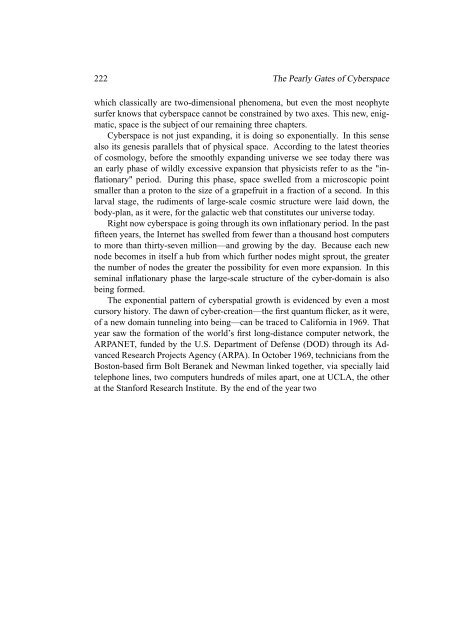The Pearly Gates of Cyberspace: - University of Exeter
The Pearly Gates of Cyberspace: - University of Exeter
The Pearly Gates of Cyberspace: - University of Exeter
Create successful ePaper yourself
Turn your PDF publications into a flip-book with our unique Google optimized e-Paper software.
222 <strong>The</strong> <strong>Pearly</strong> <strong>Gates</strong> <strong>of</strong> <strong>Cyberspace</strong><br />
which classically are two-dimensional phenomena, but even the most neophyte<br />
surfer knows that cyberspace cannot be constrained by two axes. This new, enigmatic,<br />
space is the subject <strong>of</strong> our remaining three chapters.<br />
<strong>Cyberspace</strong> is not just expanding, it is doing so exponentially. In this sense<br />
also its genesis parallels that <strong>of</strong> physical space. According to the latest theories<br />
<strong>of</strong> cosmology, before the smoothly expanding universe we see today there was<br />
an early phase <strong>of</strong> wildly excessive expansion that physicists refer to as the "inflationary"<br />
period. During this phase, space swelled from a microscopic point<br />
smaller than a proton to the size <strong>of</strong> a grapefruit in a fraction <strong>of</strong> a second. In this<br />
larval stage, the rudiments <strong>of</strong> large-scale cosmic structure were laid down, the<br />
body-plan, as it were, for the galactic web that constitutes our universe today.<br />
Right now cyberspace is going through its own inflationary period. In the past<br />
fifteen years, the Internet has swelled from fewer than a thousand host computers<br />
to more than thirty-seven million—and growing by the day. Because each new<br />
node becomes in itself a hub from which further nodes might sprout, the greater<br />
the number <strong>of</strong> nodes the greater the possibility for even more expansion. In this<br />
seminal inflationary phase the large-scale structure <strong>of</strong> the cyber-domain is also<br />
being formed.<br />
<strong>The</strong> exponential pattern <strong>of</strong> cyberspatial growth is evidenced by even a most<br />
cursory history. <strong>The</strong> dawn <strong>of</strong> cyber-creation—the first quantum flicker, as it were,<br />
<strong>of</strong> a new domain tunneling into being—can be traced to California in 1969. That<br />
year saw the formation <strong>of</strong> the world’s first long-distance computer network, the<br />
ARPANET, funded by the U.S. Department <strong>of</strong> Defense (DOD) through its Advanced<br />
Research Projects Agency (ARPA). In October 1969, technicians from the<br />
Boston-based firm Bolt Beranek and Newman linked together, via specially laid<br />
telephone lines, two computers hundreds <strong>of</strong> miles apart, one at UCLA, the other<br />
at the Stanford Research Institute. By the end <strong>of</strong> the year two

















